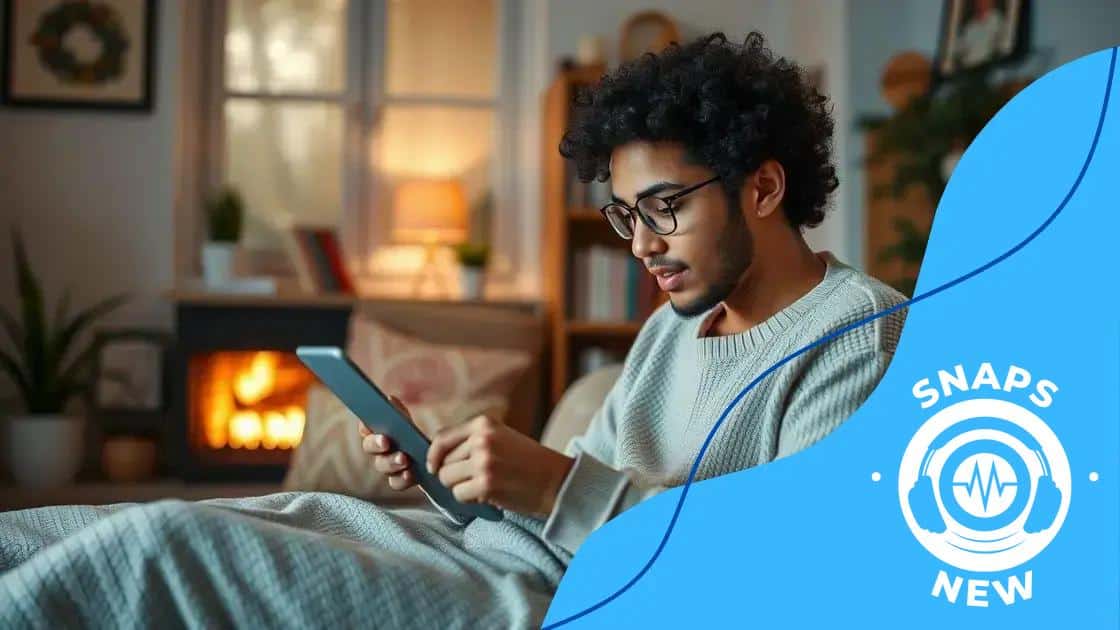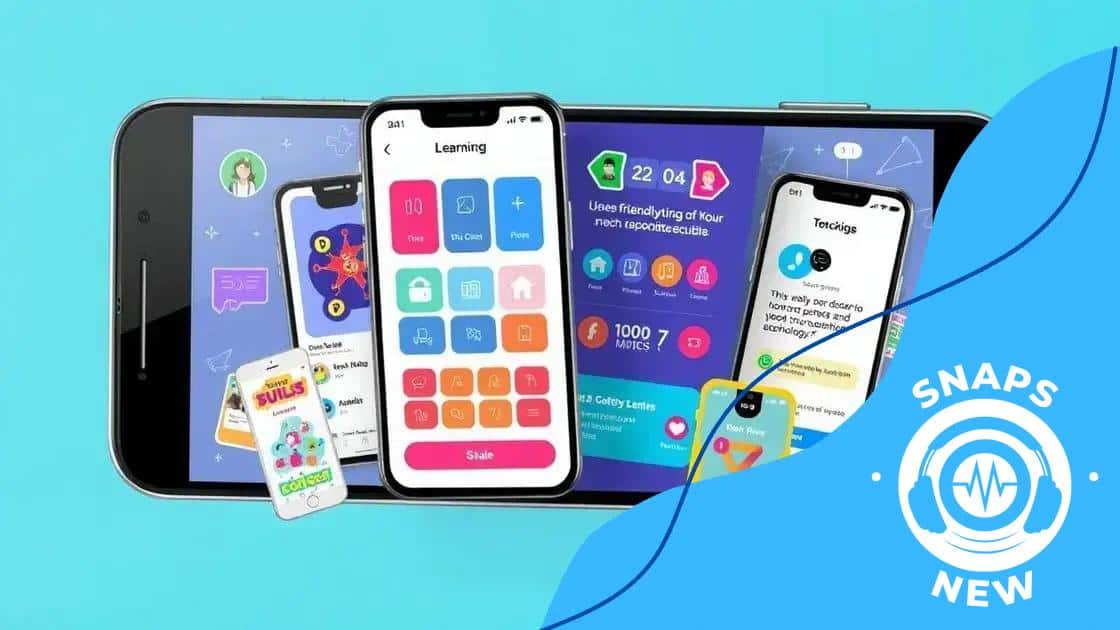Mobile learning platforms: revolutionizing education

Mobile learning platforms transform education by offering flexible, personalized learning experiences that leverage technology, ensuring accessibility and engagement for diverse learners worldwide.
Mobile learning platforms are changing how we access education, making learning more flexible and engaging than ever. Have you considered how these tools could benefit your education or training? Let’s dive in!
Understanding mobile learning platforms
Understanding mobile learning platforms is essential as they reshape the way we learn. These platforms provide tools that enable users to access educational materials anytime and anywhere.
What Are Mobile Learning Platforms?
Mobile learning platforms are applications and technologies designed for learning through mobile devices. They include features that facilitate interactive learning experiences. These platforms help bridge the gap between traditional learning and digital access, allowing users to learn at their own pace.
Key Features of Mobile Learning Platforms
Some essential features make mobile learning platforms effective:
- Accessibility: Users can access courses and materials on various devices.
- Engagement: Many platforms include quizzes, videos, and forums to engage learners.
- Analytics: Tracking learner progress helps improve the educational experience.
Moreover, these platforms often employ gamification techniques. This strategy makes learning fun and rewarding, motivating users to keep exploring new content. For example, earning badges or leveling up can make learning more appealing.
Types of Mobile Learning Applications
There are different types of mobile learning applications available today:
- Course Management Apps: Platforms where teachers can share lectures and assignments.
- Interactive Learning Apps: Applications that focus on quizzes and games to teach concepts.
- Resource Sharing Apps: Platforms where users can access articles, videos, and other educational materials.
These various types cater to different learning styles, providing flexibility for users. As technology progresses, we can expect mobile learning to become an even more integral part of education.
Benefits of mobile learning for diverse learners
The benefits of mobile learning for diverse learners are significant. Mobile learning platforms offer tailored experiences that meet the unique needs of various individuals. This flexibility allows students to learn in ways that best suit their preferences and circumstances.
Accessibility and Flexibility
One major advantage of mobile learning is its accessibility. Learners can access content from anywhere, whether at home, on the bus, or in a café. This mobility empowers them to incorporate learning into their daily routines. Additionally, courses can be designed to fit into diverse schedules, helping users manage their time effectively.
Personalized Learning Experience
Mobile learning also facilitates a more personalized experience. Educators can tailor content to meet specific learning styles. For example, visual learners benefit from videos and graphics, while auditory learners can engage with podcasts and audio notes. This customization enhances retention and understanding.
- Variety of Learning Formats: Courses can include text, video, and interactive elements.
- Self-Paced Learning: Students can progress according to their readiness.
- Feedback and Assessment: Immediate feedback encourages learners to improve.
Furthermore, mobile learning platforms often include collaborative tools. These tools promote interaction among students, fostering a sense of community. Users can participate in discussion forums, share resources, and support each other’s learning journeys.
Inclusion of Underrepresented Groups
Mobile learning breaks down barriers for underrepresented groups. It provides access to quality education for those who might face challenges in traditional settings. For learners with disabilities, mobile platforms often include features that enhance usability, such as voice recognition and accessible design.
The global reach of mobile learning is another important factor. Students in remote areas can access high-quality resources and teaching methods that were once unavailable to them. This accessibility helps level the educational playing field, allowing everyone an opportunity to succeed.
Key features to look for in mobile learning apps

When choosing mobile learning apps, it’s important to consider the key features that enhance the learning experience. These features can significantly impact how effectively users engage with the content and retain information.
User-Friendly Interface
First, a user-friendly interface is crucial. The app should allow easy navigation, making it simple for learners to find what they need. A clean and organized layout helps users focus on learning instead of struggling to use the app.
Interactive Learning Elements
Another important feature is the inclusion of interactive elements. Apps that offer quizzes, discussions, and multimedia content keep learners engaged. Interactive features can include:
- Quizzes and Games: Fun ways to reinforce knowledge.
- Discussion Forums: Spaces to collaborate and share ideas.
- Videos and Podcasts: Alternative formats that cater to different learning styles.
In addition, mobile learning apps should provide offline capabilities. This feature allows students to download materials and access them without an internet connection, making learning possible anywhere.
Progress Tracking and Analytics
Progress tracking is another vital feature. Learners benefit from tools that allow them to monitor their achievements and identify areas that need improvement. Analytics offer insights into learning patterns, helping users adjust their study habits accordingly.
Moreover, personalization options can greatly enhance the learning experience. Apps that adapt content based on user preferences and progress cater to individual learning paths. This customization ensures users remain engaged and motivated throughout their educational journey.
Support and Resources
Finally, reliable customer support is essential. An app with responsive support teams can assist users when they encounter issues or have questions. Additionally, access to extra resources can enhance the learning experience by providing further reading or practice materials.
By focusing on these key features, learners can select mobile learning apps that truly meet their needs and enhance their education.
Challenges in implementing mobile learning
Implementing mobile learning can come with various challenges that educators and institutions must address. Recognizing these obstacles is crucial for creating effective solutions that enhance the learning experience.
Technology Access Issues
One significant challenge is ensuring access to the necessary technology. Not all students have smartphones or tablets, and some areas may lack reliable internet connections. This digital divide can create disparities in learning opportunities.
User Engagement
Another obstacle is user engagement. While mobile learning can be interactive, keeping learners interested is vital. Many learners may struggle with self-motivation and distraction. For example, notifications from other apps can draw attention away from educational content.
Content Quality and Relevance
Quality of content is also crucial. Not all mobile learning resources are created equal. To be effective, educational materials must be relevant, accurate, and well-designed. Poor quality content can lead to misunderstandings and frustration among learners.
- Developing high-quality materials: Resources should be engaging and appropriately challenging.
- Regular updates: Learning content should be kept current to remain relevant.
- Feedback opportunities: Incorporating student feedback can improve material effectiveness.
Moreover, training for both educators and students is essential. Understanding how to use mobile learning tools effectively can make a significant difference. Lack of training can lead to improper usage and diminished educational outcomes.
Integration with Traditional Learning
Integrating mobile learning with traditional classroom settings can also pose a challenge. Instructors may find it difficult to balance face-to-face teaching with digital resources. Ensuring both methods complement each other rather than compete for attention is crucial.
By addressing these challenges, educators can work towards more inclusive and effective mobile learning solutions. They can create environments that maximize the benefits of mobile technology in education.
Future trends in mobile education
The future of mobile education is bright and filled with exciting possibilities. As technology evolves, so do the methods and tools available for learning on the go. Innovations in this field are reshaping the educational landscape.
Increased Personalization
One of the key trends is increased personalization. Mobile learning apps are integrating advanced algorithms to tailor educational content to individual learning styles. This means that users can engage with material that suits their pace and preferences, enhancing their overall experience.
Integration of Augmented and Virtual Reality
Another trend is the incorporation of augmented reality (AR) and virtual reality (VR) in learning. These technologies make education more immersive and interactive. For example, students can explore historical sites or conduct virtual science experiments from the comfort of their homes.
- Interactive simulations: Realistic scenarios that enhance understanding.
- Gamified learning: Engaging content that motivates students through game-like elements.
- Virtual classrooms: Enabling real-time collaboration among students from different locations.
Moreover, artificial intelligence (AI) plays a significant role in mobile education’s future. AI can provide instant feedback, making learning more efficient. For instance, chatbots can assist students 24/7, answering questions and guiding them through lessons.
Focus on Lifelong Learning
There is also a growing emphasis on lifelong learning. Mobile education is facilitating a culture where learning does not stop after formal schooling. Individuals can continually improve their skills and knowledge through online courses and resources available on their devices. This flexibility empowers learners to adapt to changing job markets.
Finally, community-driven platforms are emerging. Learners can connect and collaborate with peers globally, sharing resources and experiences. This network of support fosters a community of continuous improvement and shared learning.
FAQ – Frequently Asked Questions about Mobile Learning
What are the benefits of mobile learning?
Mobile learning offers flexibility, accessibility, and personalized experiences, allowing learners to study at their own pace.
How does mobile learning enhance engagement?
It incorporates interactive elements like quizzes, games, and multimedia content, which help keep learners interested.
What challenges might I face implementing mobile learning?
Challenges include technology access issues, ensuring content quality, and maintaining user engagement.
What future trends should I expect in mobile education?
Expect innovations like augmented reality, artificial intelligence, and a focus on lifelong learning and global collaboration.





